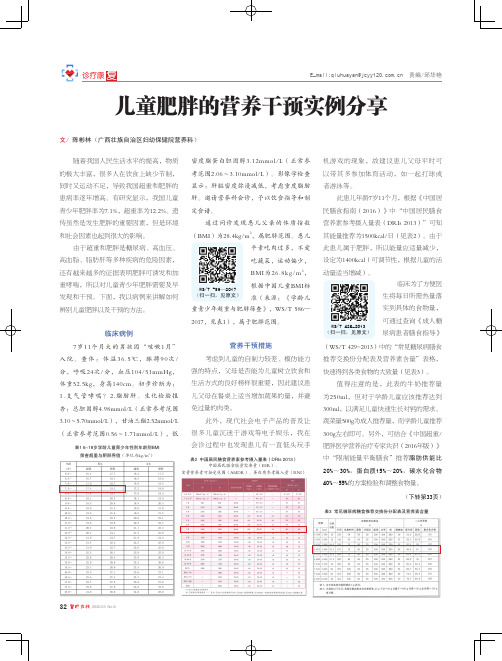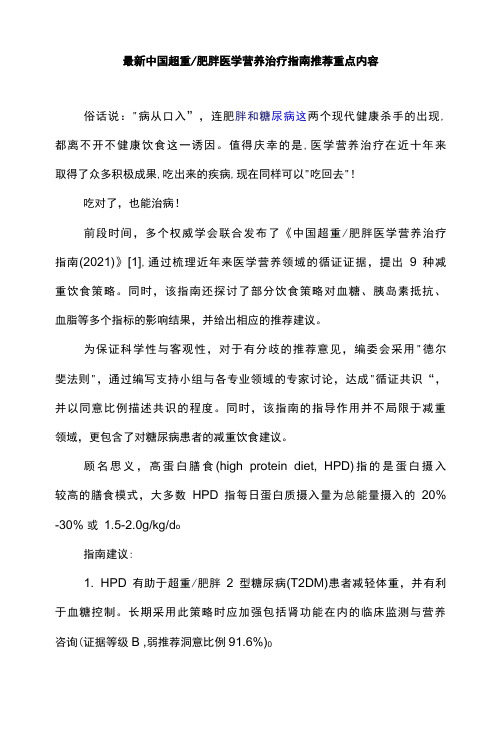肥胖的营养治疗
营养学-肥胖的营养治疗

酒精含有空热量,不利于减肥 ,应尽量避免或限制饮酒量。
运动治疗
01
02
03
04
增加有氧运动
如快走、跑步、游泳等,有助 于燃烧脂肪,提高心肺功能。
增加肌肉力量训练
如举重、俯卧撑等,有助于增 加肌肉量,提高基础代谢率。
适量运动
根据个人情况选择适量的运动 强度和时间,避免过度疲劳。
坚持运动
保持运动习惯,长期坚持才能 取得良好的减肥效果。
药物治疗
在医生的指导下使用减肥药物
注意药物副作用
部分肥胖患者可在医生指导下使用减肥药 物辅助减肥。
药物治疗可能存在一定的副作用,应在医 生指导下使用,并密切关注身体反应。
药物治疗不是长期解决方案
谨慎选择非处方减肥药物
药物治疗只是辅助手段,不能替代健康的 饮食和运动习惯。
非处方减肥药物可能存在安全隐患,应谨 慎选择,避免盲目使用。
谷物的摄入。
规律饮食
02
保持每天三餐定时定量,避免暴饮暴食和过度进食。
减少快餐和加工食品的摄入
03
鼓励选择新鲜、天然的食物,减少快餐和过度加工食品的摄入。
增加体育锻炼
01
02
03
有氧运动
如快走、跑步、游泳等有 氧运动有助于燃烧脂肪, 提高心肺功能。
力量训练
进行适量的力量训练可以 增加肌肉量,提高基础代 谢率。
蛋白质是肌肉合成的关键营养 素,合理的蛋白质摄入有助于 维持肌肉健康,避免减重过程 中的肌肉流失。建议选择低脂 肪的蛋白质来源,如鱼、鸡胸 肉、豆腐等。
脂肪摄入过多是肥胖的主要原 因之一。营养学建议控制饱和 脂肪和反式脂肪的摄入,以降 低脂肪堆积的风险。富含健康 脂肪的食物包括橄榄油、鱼油 和坚果。
营养学——肥胖的营养防治

85.5g 77.7g 68.3g城市48.3g 39.6g
农村
中国居民脂肪摄入量的变化(1982~2002)
1982 1992 2002
饮食、营养因素与肥胖的关系
3、摄食量过大,能量摄入过多会直接导致肥胖 ①遗传因素 ②社会、环境及心理因素:食物极大的丰富、快餐 食品、高能量的食品、运动少等; ③个人饮食习惯:进食速度过快、暴饮暴食、进食 时间过长、习惯吃零食、吃夜宵、三餐分配不合理 (晚餐过饱)。
肥胖的饮食营养防治原则
3、多摄入低血糖指数的食物(LGI)的膳食
LGI膳食(GI<55),可增加饱腹感,减少能 量摄入,并且可改善代谢紊乱 。
4、补充某些营养素 补充多不饱和脂肪(n-3系)、MUFA 、钙、
硒等矿物质以及维生素类,有助于减肥并可改善 代谢紊乱
肥胖的饮食营养防治原则
5、补充某些植物化学物
三餐能量比:30%、40%、30%
推荐每天只要减少500kcal的能量摄入, 就能达到每周减轻0.5kg体重效果。
肥胖的饮食营养防治原则
2、改变宏量营养素构成
公认
低脂(low fat,LF) 低碳水化合物(low carbonhydrate,LC) 高蛋白质(high protein,HP)
高蛋白(供能比占20%~25%)、低脂肪(供能比占30%以 下)、低碳水化合物(供给比占45%~50%)的膳食的减体 重效果最佳。
异黄酮、皂苷等植物化学物在减肥和改 善代谢综合症方面有一定作用。
肥胖的饮食营养防治原则
结语:减肥=控制饮食+运动
(1)有助于维持减肥状态,防止反弹;
运 (2)改善代谢紊乱; 动 (3)改善心情和健康状态;
(4)预防多种慢性疾病,如心脏疾病、糖 尿病、癌症等,甚至降低死亡率。
儿童肥胖的营养干预实例分享

322020.03 No.8文/ 陈彬林(广西壮族自治区妇幼保健院营养科)随着我国人民生活水平的提高,物质的极大丰富,很多人在饮食上缺少节制,同时又运动不足,导致我国超重和肥胖的患病率逐年增高。
有研究显示,我国儿童青少年肥胖率为7.1%,超重率为12.2%。
遗传虽然是发生肥胖的重要因素,但是环境和社会因素也起到很大的影响。
由于超重和肥胖是糖尿病、高血压、高血脂、脂肪肝等多种疾病的危险因素,还有越来越多的证据表明肥胖可诱发和加表2 中国居民膳食营养素参考摄入量表(DRIs 2013)中国居民膳食能量需要量(EER)、宏量营养素可接受范围(AMDR)、蛋白质参考摄入量(RNI)表3 常见糖尿病膳食推荐交换份分配表及营养素含量童青少年超重与肥胖筛查》,WS/T 586—2017,见表1),属于肥胖范围。
营养干预措施考虑到儿童的自制力较差、模仿能力强的特点,父母是否能为儿童树立饮食和生活方式的良好榜样很重要,因此建议患儿父母在餐桌上适当增加蔬果的量,并避免过量的肉类。
此外,现代社会电子产品的普及让很多儿童沉迷于游戏等电子娱乐,我在会诊过程中也发现患儿有一直低头玩手(WS/T 429-2013)中的“常见糖尿病膳食推荐交换份分配表及营养素含量”表格,快速得到各类食物的大致量(见表3)。
值得注意的是,此表的牛奶推荐量为250ml,但对于学龄儿童应该推荐达到300ml,以满足儿童快速生长对钙的需求。
蔬菜量500g为成人推荐量,而学龄儿童推荐300g左右即可。
另外,可结合《中国超重/肥胖医学营养治疗专家共识(2016年版)》中“限制能量平衡膳食”推荐20%~30%,蛋白质15%~20%,碳水化合物40%~55%的方案检验和调整食物量。
WS/T 429-2013(扫一扫,见原文)WS/T 586—2017(扫一扫,见原文)以及根据发作情况再调整剂量;并嘱患儿不要再食用自制饼干,规避其中可能存在的过敏原如牛奶、鸡蛋、面粉等。
最新中国超重肥胖医学营养治疗指南推荐重点内容

最新中国超重/肥胖医学营养治疗指南推荐重点内容俗话说:"病从口入”,连肥胖和糖尿病这两个现代健康杀手的出现, 都离不开不健康饮食这一诱因。
值得庆幸的是,医学营养治疗在近十年来取得了众多积极成果,吃出来的疾病,现在同样可以"吃回去"!吃对了,也能治病!前段时间,多个权威学会联合发布了《中国超重/肥胖医学营养治疗指南(2021)》[1],通过梳理近年来医学营养领域的循证证据,提出9种减重饮食策略。
同时,该指南还探讨了部分饮食策略对血糖、胰岛素抵抗、血脂等多个指标的影响结果,并给出相应的推荐建议。
为保证科学性与客观性,对于有分歧的推荐意见,编委会采用"德尔斐法则",通过编写支持小组与各专业领域的专家讨论,达成"循证共识“,并以同意比例描述共识的程度。
同时,该指南的指导作用并不局限于减重领域,更包含了对糖尿病患者的减重饮食建议。
顾名思义,高蛋白膳食(high protein diet, HPD)指的是蛋白摄入较高的膳食模式,大多数HPD指每日蛋白质摄入量为总能量摄入的20% -30% 或1.5-2.0g/kg/d o指南建议:1. HPD有助于超重/肥胖2型糖尿病(T2DM)患者减轻体重,并有利于血糖控制。
长期采用此策略时应加强包括肾功能在内的临床监测与营养咨询(证据等级B ,弱推荐洞意比例91.6%)02. HPD可增加饱腹感、减轻饥饿感,有助于增强重度肥胖者的减重依从性并维持减重效果(证据等级C,弱推荐;同意比例93.3%)。
此外,蛋白质的食物来源广泛,不同来源的蛋白质在HPD中扮演不同的角色。
1. HPD保持以乳制品为主的优质蛋白来源更有助于维持骨量(证据等级B ,弱推荐洞意比92.0%)。
2. 以酪蛋白水解物、孚榜青蛋白水解物或大豆蛋白为蛋白来源的HPD 补充剂,均有助于减重(证据等级B ,弱推荐洞意比例95.4%)。
低碳水化合物饮食:低碳水化合物饮食(low carbohydrate diets , LCDs)通常指膳食中碳水化合物供能比《40% ,脂肪供能比Z 30% ,蛋白质摄入量相对增加,限制或不限制总能量摄入的_类饮食,近几年非常网红的生酮饮食就属于LCDs。
肥胖症营养治疗原则

肥胖症营养治疗原则一.临床症状肥胖正确定义是机体脂肪过度积聚与脂肪组织过量扩增,判断肥胖的科学方法是准确测定机体脂肪或脂肪组织的量。
通常个人实际体重如超过标准体重的10%即为过重,应因其足够关注;若超过20%而无原因,即可诊断为肥胖。
超过20%~30%者为轻度肥胖、30%~50%为中度肥胖、50%以上为重度肥胖、100%以上者为病态肥胖。
肥胖和过重,虽然都是集体能量正平衡的结果,但有不同内涵。
肥胖固然可以导致过重,但运动员及体力劳动者的过重,常不是肥胖而是因为肌肉发达所致。
反之,平时不爱活动或活动量极少的虚胖者,即使不过重,但也有体脂过度积聚。
二.肥胖综合征轻度肥胖除体重过重外,无其他症状;中都以上肥胖者,常有下列综合征及症状。
1.通气不良综合征2.心血管系统症状3.内分泌代谢紊乱4.消化系统症状食欲亢进、多食善饥、便秘、腹胀等,尤其是妇女有也是综合征,表现为夜间食欲旺盛、失眠、白天厌食;伴有胆石症肥胖者,有慢性消化不良与胆绞痛发作。
三.并发症1.并发糖尿病2.并发高血压病3.并发高血脂症及冠心病4.并发胆石症四.营养原则保证机体蛋白质及其他各种营养素需要,维持机体摄入量与消耗间的负平衡状态,并持续相当长时间,使体重逐渐下降,接近标准体重,达到减轻体重的目的。
肥胖直接起因是长期能量摄入量超标,治疗就必须坚持足够时间,切不可急于求成。
建立控制饮食和增加体力活动措施,是取得疗效和巩固疗效的保证。
五.营养治疗1.限制总能量能量现只要逐渐降低,避免骤然降至最低安全水平以下,应适可而止。
辅以适当体力活动,增加能量消耗。
成年轻度肥胖者,按每月减轻体重0.5~1.0kg为宜。
而成年中度以上肥胖者,每周减轻体重0.5~1.0kg。
每人饮食应尽量供给能量1000kcal/d,这是可以较长时间坚持的最低安全水平。
2.蛋白质肥胖者因摄入能量过多,过多能量不论来自何种能源物质,都可引起肥胖,食物蛋白当然也不例外。
同时,严格限制饮食能量供给,蛋白质营养过度还会导致肝肾功能损害,故低能量饮食蛋白质供给不宜过高,并选用高声物价值蛋白,如牛奶、鱼、鸡、鸡蛋清、瘦肉等。
《中国超重肥胖医学营养治疗指南(2021)》解读

《中国超重/肥胖医学营养治疗指南(2021)》解读医学减重干预方法1.限能量膳食限能量膳食(CRD)是指在目标能量摄入基础上每日减少能量摄入500~1000 kcal (男性为1200~1400 kcal/d,女性为1000~1200 kcal/d),或较推荐摄入量减少1/3总能量,其中碳水化合物占每日总能量的55%~60%,脂肪占每日总能量的25%~30%问题1:蛋白质来源对CRD干预的作用有何影响?提高大豆蛋白摄入比例的CRD可降低体脂率、血清总胆固醇(TC)和低密度脂蛋白胆固醇(LDL-C)水平。
(证据等级C,弱推荐;同意比例94.9%)问题2:增加乳制品摄入量对CRD的减重干预有何影响?增加乳制品摄入量可降低超重/肥胖者的体重和体脂含量,而单纯增加钙补充剂并不能增强减重效果。
(证据等级B,弱推荐;同意比例92.4%)2.高蛋白膳食高蛋白膳食(HPD)包括相对数量(蛋白质供能比)和绝对数量(蛋白质摄入量)的界定,多数HPD指每日蛋白质摄入量超过每日总能量的20%或1.5 g/(kg·d),但一般不超过每日总能量的30%或>2.0 g/(kg·d)的膳食模式。
问题3:HPD能否改善超重/肥胖2型糖尿病(T2DM)患者的体重和血糖?HPD有助于超重/肥胖T2DM患者减轻体重,并有利于血糖控制。
长期应用时应加强包括肾功能在内的临床监测与营养咨询。
(证据等级B,弱推荐;同意比例91.6%)问题4:HPD对减重依从性和维持减重效果的影响?HPD可增加饱腹感、减轻饥饿感,有助于增强重度肥胖者的减重依从性并维持减重效果。
(证据等级C,弱推荐;同意比例93.3%)问题5:HPD减重会引起骨质丢失吗?HPD保持以乳制品为主的优质蛋白来源更有助于维持骨量。
(证据等级B,弱推荐;同意比例92.0%)问题6:不同蛋白来源的HPD补充剂对减重的影响?以酪蛋白水解物、乳清蛋白水解物或大豆蛋白为蛋白来源的HPD补充剂,均有助于减重。
中国超重/肥胖医学营养治疗专家共识(2016年版)

中国超重/肥胖医学营养治疗专家共识(2016年版)一、背景近二十年来,我国超重/肥胖的患病率逐年增长,呈流行态势。
中国健康营养调查(CHNS)的数据显示【1】,从1993年至2009年的17年间,成年人超重/肥胖的患病率从13.4%增加至26.4%,总体呈线性增长;成年人腹型肥胖的患病率从18.6%增长至37.4%,平均年增长1.1%,显著高于超重/肥胖的增长速度。
肥胖是糖尿病、心血管疾病及其他代谢性疾病和肿瘤的潜在危险因素。
减重治疗包括生活方式(膳食和体育运动)调整、内科药物及外科手术治疗等多种手段。
科学合理的营养治疗联合运动干预仍是目前最有效、最安全的基础治疗。
近年来,国际上对肥胖/超重的营养管理已经形成了一些共识【2-3】。
然而,以营养和生活方式干预为核心的肥胖/超重管理必须与特定的地域性饮食习惯及社会文化相适应。
为更好地发挥医学营养治疗在肥胖防治中的作用,结合国内外发表的诸多证据和专家的集体智慧,特制定本共识,以便使医学减重更加科学、规范和易于实施。
二、证据分级与推荐意见的形成在制定本共识的过程中,首先参照世界卫生组织(WHO)出版的《WHO指南编写手册》【4】和指南研究与评价工具(AGREE)协作网【5】发表的临床指南编写的方法学原则(表1),结合中国现况,建立制定本共识的方法学,将2009年更新后的AGREEⅡ协作网推出的指南方法学质量评价标准作为质控标准【5】。
2015年9月,成立了超重/肥胖医学营养治疗专家共识(2016)(以下简称“共识”)撰写证据方法学小组,负责起草方法学工作方案,并协助编委会进行证据评价的相关工作。
证据级别与推荐意见分级标准的制定见表2。
注:RCT(随机对照试验);A、B、C、D:(推荐意见优先级别从高到低)三、共识编写委员会组织机构由中国医疗保健国际交流促进会营养与代谢管理分会以及中国医师协会营养医师专业委员会、中国营养学会的67位专家组成了本共识编写委员会。
肥胖症患者的营养干预策略及其心理健康影响

肥胖症患者的营养干预策略及其心理健康影响在当今社会,肥胖症已经成为一个日益严重的公共健康问题。
肥胖不仅影响个人的外貌形象,更对身体健康构成了诸多威胁,如增加患糖尿病、心血管疾病、高血压等慢性疾病的风险。
同时,肥胖症还会对患者的心理健康产生不容忽视的影响。
因此,对于肥胖症患者来说,采取有效的营养干预策略至关重要,并且关注其心理健康同样不可或缺。
首先,我们来探讨一下肥胖症患者的营养干预策略。
营养干预的核心目标是通过调整饮食结构和饮食习惯,实现热量摄入与消耗的平衡,从而促进体重的减轻和健康状况的改善。
控制总热量摄入是关键的第一步。
肥胖症患者需要对每天摄入的热量有清晰的认识,并根据自身的身体情况、活动水平和减重目标来制定合理的热量摄入计划。
一般来说,对于轻度肥胖的人,每天可以减少 500 1000 千卡的热量摄入;而对于重度肥胖者,可能需要减少更多。
在食物的选择上,应增加蔬菜、水果、全谷物、低脂肪蛋白质(如鸡胸肉、鱼虾、豆类等)的摄入。
蔬菜和水果富含维生素、矿物质和膳食纤维,能够提供饱腹感,同时热量相对较低。
全谷物则保留了更多的营养成分和膳食纤维,有助于稳定血糖水平,减少饥饿感。
低脂肪蛋白质不仅有助于维持肌肉质量,还能增加饱腹感,减少对高热量食物的渴望。
减少高热量、高脂肪和高糖的食物是必须的。
油炸食品、奶油蛋糕、巧克力、糖果等往往含有大量的不健康脂肪和糖分,容易导致热量过剩。
同时,要控制碳水化合物的摄入量,尤其是精制谷物(如白面包、白米饭)和含糖饮料。
这些食物会迅速升高血糖,促使胰岛素大量分泌,进而促进脂肪的合成和储存。
饮食的规律和均衡也非常重要。
定时定量进餐,避免暴饮暴食和过度节食。
每天可以安排三餐加上适量的加餐,这样有助于稳定血糖和代谢水平。
此外,还要注意饮食的细节,比如控制食物的分量,使用较小的餐盘和餐具可以在视觉上帮助减少食物的摄入量。
除了饮食方面的调整,肥胖症患者还需要关注水分的摄入。
充足的水分摄入有助于代谢废物的排出,维持身体的正常生理功能。
- 1、下载文档前请自行甄别文档内容的完整性,平台不提供额外的编辑、内容补充、找答案等附加服务。
- 2、"仅部分预览"的文档,不可在线预览部分如存在完整性等问题,可反馈申请退款(可完整预览的文档不适用该条件!)。
- 3、如文档侵犯您的权益,请联系客服反馈,我们会尽快为您处理(人工客服工作时间:9:00-18:30)。
第十三章代谢性疾病营养治疗第一节肥胖症Obesity is defined as an excess body fat content for stature. Ideally, the best assessment of obesity would be a measure of actual body fat. Among adults, the body mass index (BMI, expressed askg/m2) has been recommended internationally as a measure of obesity. A BMI between 25.0 and 29.9 defines overweight (24.0 to 27.9 for Chinese); a BMI ≥30 defines obesity (≥28 for Chinese). Unlike adult, no universal definition of the weight-for-height measures necessary to define obesity in youth exists, but definitions have been proposed. WHO expert committee recommended that for infants and children a child’s weight for height be compared with mean age- and sex-specific values in the National Center for Health Statistics (NCHS) and WHO reference data. Children with aweight-for-height value >2 standard deviation scores (Z score) above the median are classified as overweight. For adolescents the committee recommended BMI as the best indicator; however, age and sex must still be considered. Adolescents whose age- andsex-specific BMI is ≥85th percentile BMI of a reference population are classified as at risk for overweight.Obesity can be viewed as both a disease and a risk factor for chronic disease and other morbidities. Increased fat in the abdominal region predicts physiological risk factors for cardiovascular disease (CVD), independent of body mass. Among adults, both ratio of waist circumference to hip circumference and the waist circumference alone have been used to assess body fat distribution. Waist-to hipratios >1.0 for men and >0.85 for women have been used to identifypeople at increased risk for morbidity. For both adults and children, obesity is associated with a higher prevalence of risk factors for cardiovascular disease and type 2 diabetes. People with overweight or obesity are more likely than normal-weight people to experience elevated blood pressure; dyslipidemias, such as high levels of total cholesterol, triglycerides, and LDL and low levels of HDL; and insulin resistance. They are also more likely to experience 2 or more these risk factors.Ultimately, overweight and obesity are caused by a chronic imbalance between energy intake and energy expenditure. Two behaviors are thought to contribute to energy imbalance; excessive energy intake and inadequate physical activity. Genetics also contribute significantly to obesity. Ultimately, any intervention to facilitate weight loss or prevent weight gain must result in an appropriate relation between energy expenditure and energy intake within the individuals: to facilitate weight loss, expenditure must exceed intake; to prevent weight gain, expenditure must equal energy intake.The goal of dietary modification is to reduce energy intake. This strategy is an important and effective strategy to facilitate weight loss for both adults and children. Among overweight adults, low-calorie diets (3.35-6.28MJ[800-1500 kcal]/d) can reduce body weight by an average of 8% over 3-12 months. Increased physical activity may aid weight loss by increasing energy expenditure and by helping maintain lean body mass and thus resting metabolic rate. Increased physical activity contributes modestly to weight loss for both adults and children, but the effect of physical activity alone is generally smaller than that of energy reduction. Physical activity does appear to be important in long-term weight maintenance.一、概述肥胖症(obesity)是指体内储存过多的脂肪。
表现为脂肪细胞体积增大和(或)脂肪细胞数增多。
正常成年男子的脂肪组织约占体重的15%~20%,女子占20%~25%。
若成年男子脂肪组织超过20%~25%,女子超过30%,即为肥胖。
常表现为体重超过相应身高体重标准值的20%以上。
按病因和发病机制,肥胖症可分为单纯性肥胖(simple obesity)和继发性肥胖两大类。
前者是遗传因素和环境因素共同作用的结果,是一种慢性代谢异常疾病,它常与高血压、高脂血症、冠心病、2型糖尿病等集结出现或是这些疾病的重要危险因素。
随着生活水平的改善和体力劳动的减少,肥胖症有逐年增加的趋势,已成为世界性的健康问题之一。
继发性肥胖症是某些疾病(如甲状腺功能减退症、性功能减退症、下丘脑-垂体炎症、肿瘤、库欣综合征等)的临床表现之一。
本节主要讨论单纯性肥胖。
肥胖症的判断主要是根据理想体重和体质指数,轻度肥胖症者无症状,中重度肥胖症者因体重负荷增大,可出现气急、关节痛、肌肉酸痛、体力活动减少等。
通常男性肥胖患者脂肪主要分布在腰部以上,集中在腹部,称为男性型、苹果型肥胖,俗称“将军肚”;女性肥胖患者脂肪主要分布在腰部以下,如下腹部、臀、大腿,称为女性型、梨型肥胖。
苹果型比梨型肥胖患者更易发生代谢综合征。
公司白领、公务员、财务人员为主,他们每天静坐时间长,普遍缺乏主动锻炼,最易肥胖。
患者常因体型而有自卑感、焦虑、内向、抑郁、孤独等心理问题,此外,肥胖患者可伴发高血压、高脂血症、糖尿病、胆石症、胆囊炎等。
二、营养代谢特点(一)能量长期能量摄入大于能量消耗量,多余的能量,不管来自哪一类能源物质(脂肪、碳水化合物或蛋白质)均可转变成脂肪储存在体内,过量的体脂储备即可引起肥胖。
摄入过多能量可发生在任何年龄,但在幼年开始多食对肥胖的发生具有重要意义。
成年起病者多为脂肪细胞体积增大,而幼年起病者多为脂肪细胞数量增多和体积增大,更不易控制。
体力活动不足引起的能量消耗下降可能是肥胖的一个原因,也可能是肥胖的后果,因为肥胖病人常受到嘲笑,自卑感强,逐渐形成内向抑郁,不愿活动,因而耗能减少,形成恶性循环。
因此,应控制能量摄入和增加能量消耗,才能纠正能量代谢的失衡。
(二)脂肪和碳水化合物膳食脂肪的能量密度高,过多摄入易使能量超标,且易发生酮症。
饱和脂肪酸易转化为体脂,引起肥胖。
